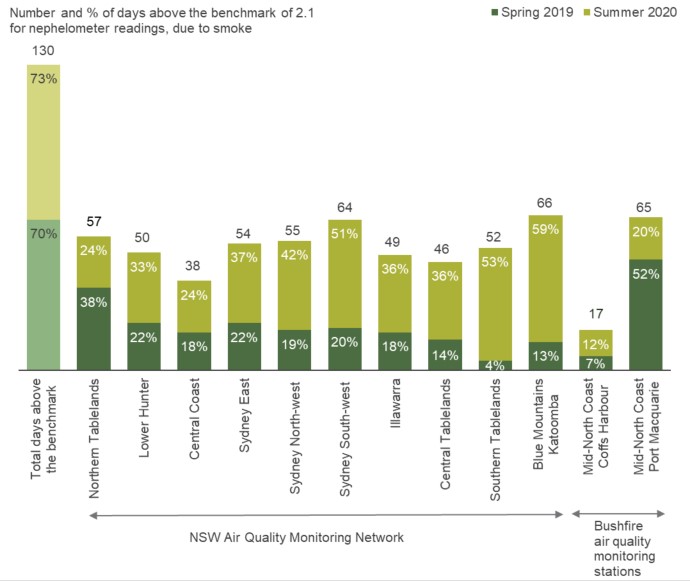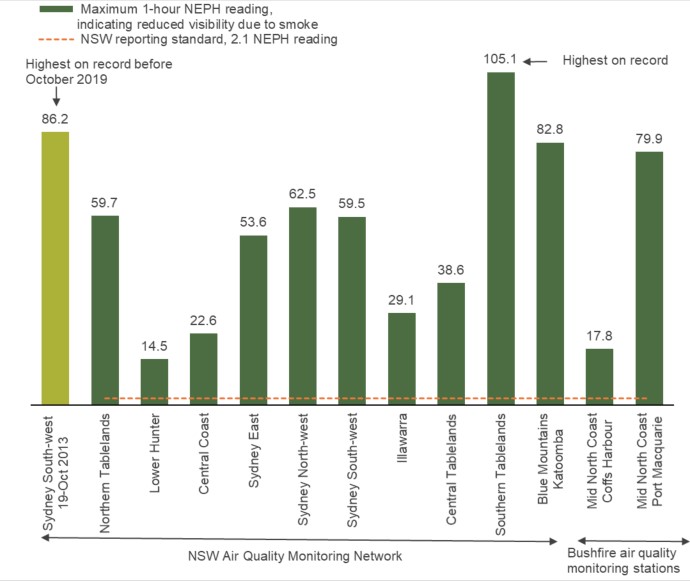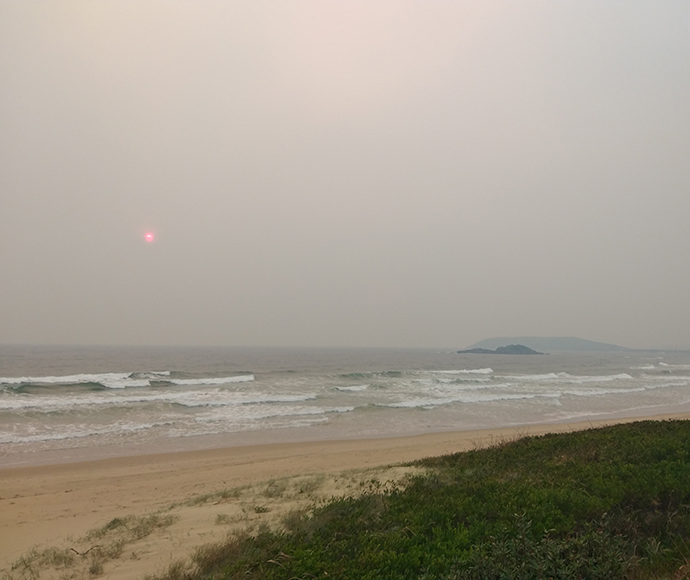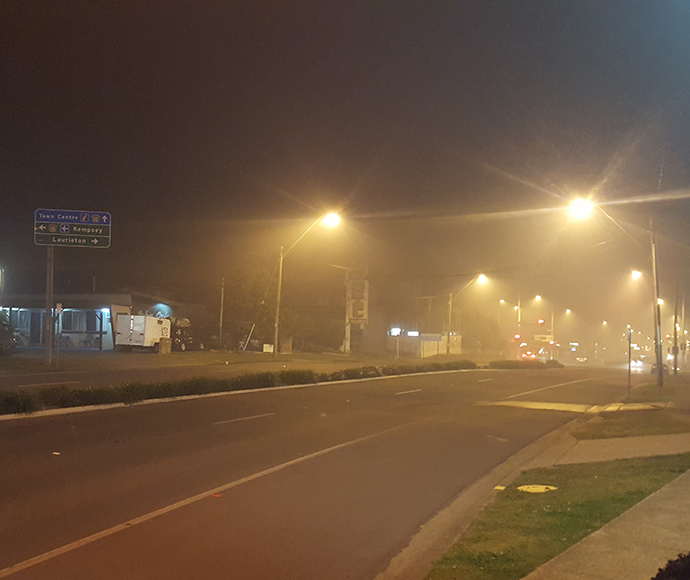Benchmark for visibility
- Hourly average – 2.1 nephelometer reading, NSW benchmark.
Note: The NSW Air Quality Monitoring Network uses nephelometers to measure variations in visibility as a light reduction index associated with airborne particles. The measurements are in units of 10-4 m-1, referred to as the NEPH reading for simplicity in this Air Quality Statement. High NEPH readings can indicate low-level visibility due to high levels of PM2.5 particles.
Key points
During the NSW bushfire season 2019–20, the extent and intensity of bushfire smoke across eastern New South Wales was indicated by high nephelometer readings across the NSW Air Quality Monitoring Network. Thick smoke reduced visibility to the lowest levels, for the longest periods, since 1994.
- NEPH readings were above the benchmark on 115 days (or 63% of days in spring–summer 2019–20) within the standard monitoring network, compared to 13 days in spring-summer 2018-19. Bushfire emergency monitoring stations recorded 66 days above the benchmark, including 15 days not recorded by the standard monitoring network.
- The highest hourly nephelometer reading since 1994 was 105.1, 50 times the benchmark, at Goulburn in the Southern Tablelands on 31 December 2019. This was due to bushfire smoke.
More detail
Maximum hourly NEPH readings across the regions in the NSW Air Quality Monitoring Network, including bushfire air quality monitoring stations, are summarised below.
- The standard monitoring network recorded 115 days above the benchmark, ranging from 38 days at Wyong in the Central Coast to 66 days at Katoomba in the Blue Mountains.
- The bushfire air quality monitoring stations on the Mid-North Coast were commissioned in November 2019 and recorded a total of 66 days above the benchmark, including 15 days that were not observed in the standard monitoring network. Port Macquarie alone recorded 65 days above the benchmark, with up to 20 consecutive days during 7–26 November.
- The daily maximum hourly NEPH readings across the standard monitoring network ranged from 14.5 (7 times the benchmark) in the Lower Hunter to 105.1 (50 times the benchmark) in the Southern Tablelands.
- Goulburn recorded the highest NEPH reading since 1994, with 105.1, at 7pm on 31 December 2019. At the same hour, Goulburn recorded the highest hourly nitrogen dioxide level since 1994. A southerly change brought thick smoke to the region from the Currowan and Palerang fires to the south and east.
- Before spring–summer 2019–20, the highest NEPH level was 86.2, 41 times the benchmark, recorded at Bargo in Sydney South-west during the NSW bushfire emergency in spring 2013.
Note: The records reported above exclude the NEPH reading of 688.1 at Earlwood in Sydney East, related to a local automobile fire incident on 12 August 2011. This was a localised event directly affecting the monitoring station and not representative of particle levels in the broader community.
Hourly average NEPH readings in spring–summer 2019–20
Standard network by region
Number of days above the benchmark:
- 66 days in the Blue Mountains, with up to 34 consecutive days from 7 December 2019 to 9 January 2020
- 54 to 64 days across stations in the Sydney regions:
- 64 days in Sydney South-west, with 19 consecutive days from 28 November to 16 December 2019
- 55 days in Sydney North-west, with 14 consecutive days from 3–16 December 2019
- 54 days in Sydney East, with 10 days consecutive days from 28 November to 7 December 2019.
- 57 days in the Northern Tablelands (measured at Armidale), with 10 consecutive days between 16–25 November and 15–24 December 2019.
- 52 days in the Southern Tablelands (measured at Goulburn), with 41 consecutive days from 8 December 2019 to 17 January 2020
- 50 days across stations in the Lower Hunter, with 8 consecutive days from 29 December 2019 to 5 January 2020
- 49 days in the Illawarra, with 8 consecutive days from 29 December 2019 to 5 January 2020
- 46 days in the Central Tablelands (measured at Orange), with 13 consecutive days from 16–28 December 2019
- 38 days in the Central Coast (measured at Wyong), with 6 consecutive days from 2–7 December 2019
Bushfire air quality monitoring stations on the Mid-North Coast
Number of days above the benchmark:, across the
- 65 days at Port Macquarie, with 20 consecutive days from 7–26 November.
- 17 days at Coffs Harbour, with 5 consecutive days from 22–26 November
Note: The Mid-North Coast most likely experienced NEPH levels above the benchmark before monitoring began at Coffs Harbour on 22 November 2019.
Standard network by region hourly NEPH
Maximum hourly NEPH readings:
- 105.1 NEPH reading, 50 times the benchmark at Goulburn in Southern Tablelands on 31 December 2019, the highest NEPH since 1994.
- 82.8 NEPH reading, 39 times the benchmark at Katoomba in the Blue Mountains on 5 January 2020. This record ranked the third highest NEPH reading since 1994.
- 53.6 to 62.5 NEPH reading, 26 to 30 times the benchmark across stations in Sydney East, Sydney South-west and Sydney North-west.
- 59.7 NEPH reading, 28 times the benchmark, at Armidale in the Northern Tablelands on 8 December 2019
- 38.6 NEPH reading, 18 times the benchmark at Orange in the Central Tablelands on 19 December 2019
- 29.1 NEPH reading, 14 times the benchmark at Wollongong in the Illawarra on 19 December 2019
- 22.6 NEPH reading, 11 times the benchmark at Wyong in the Central Coast on 5 December 2019
- 14.5 NEPH reading, 7 times the benchmark at Newcastle in the Lower Hunter on 12 November 2019
Bushfire air quality monitoring stations on the Mid-North Coast hourly NEPH
Maximum hourly NEPH readings:
- 79.9 NEPH reading, 38 times the benchmark at Port Macquarie, at 8am on 15 November 2019. This record ranked the fourth highest NEPH reading since 1994.
- 17.8 NEPH reading, 8 times the benchmark at Coffs Harbour on 23 November 2019.
1994–February 2020 – highest hourly NEPH readings
The 7 highest hourly NEPH readings in 1994-February 2020 are listed below. The first, third and fourth highest readings were recorded in spring-summer 2019-20.
- Highest, 2019: 105.1 NEPH reading, 50 times the benchmark at Goulburn in Southern Tablelands on 31 December 2019, the highest NEPH since 1994, as noted above.
- Second highest, 2013: 86.2 NEPH reading, 41 times the benchmark at Bargo in Sydney South-west on 19 October 2013, during the NSW bushfire emergency in spring 2013 (this record was associated with the nearby Balmoral-Southern Tablelands fire).
- Third highest, 2020: 82.8 NEPH reading, 39 times the benchmark at Katoomba in the Blue Mountains on 5 January 2020, noted above.
- Fourth highest, 2019: 79.9 NEPH reading, 38 times the benchmark at Port Macquarie on 15 November 2019, noted above.
- Fifth highest, 2011: 45.5 NEPH reading, 22 times the benchmark at Bargo on 17 September 2011, during hazard reduction burning.
- Sixth highest, 2009: 37.3 NEPH reading, 18 times the benchmark at Lindfield in Sydney East on 23 September, during the Red Dawn dust event in spring 2009.
- Seventh highest 2016: 28.5 NEPH reading, 14 times the benchmark, at St Marys in Sydney North-west on 7 May 2016, during hazard reduction burning by the Rural Fire Service in the Blue Mountains: High NEPH readings were also recorded at Rozelle in Sydney East.
Note: The records reported above exclude the NEPH reading of 688.1 at Earlwood in Sydney East, related to an automobile incident on 12 August 2011. Elevated hourly PM2.5 levels were recorded during these events.
Further reading
The Focus area: Data and episode analysis, in this Air Quality Statement, presents a case study on the impact of fine particle smoke on air quality in New South Wales from 2000 to 2020, based on nephelometer readings

Number and percentage of days in spring-summer 2019–20, with daily maximum one-hour nephelometer readings above the NSW standard for visibility, by region. Katoomba in Blue Mountains recorded the highest number of days, with 66 days, or 36% of spring-summer days above the benchmark and 34 consecutive days.

Maximum 1-hour nephelometer readings in spring-summer 2019–20, by region, showing the highest reading in the Southern Tablelands. Goulburn recorded a NEPH reading of 105.1, 50 times the benchmark, at 7pm on 31 December 2019. At the same hour, Goulburn recorded the highest hourly nitrogen dioxide level since 1994.

Reduced visibility at Coffs Harbour, Mid-North Coast, 22 November 2019. Port Macquarie bushfire air quality monitoring station recorded 38 days above the NSW benchmark for visibility, from 22 November to 29 February 2020, with 5 consecutive days during 22–26 November, at levels up to 8 times the benchmark.

Reduced visibility at Port Macquarie, Mid-North Coast, 19 July 2019. Port Macquarie bushfire air quality monitoring station recorded 64 days above the NSW benchmark for visibility, with 20 consecutive days during 7–26 November, at levels up to 38 times the benchmark.